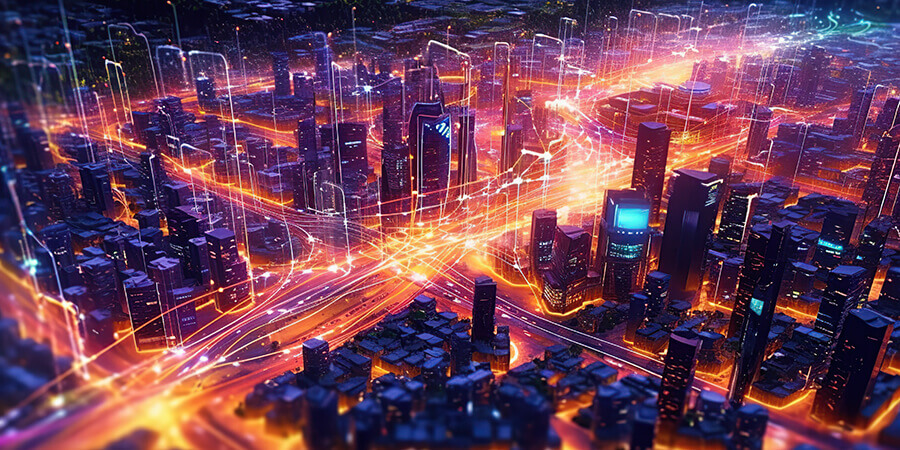The destiny of our world is intricately tied to the quality of its future cities. Technology plays a central role in enhancing urban life, and the aspiration of creating genuinely smart cities is alive like never before. As long as human civilization thrives within urban hubs, the drive to enhance the urban landscape will persist.
Throughout the history of cities, spanning some 6,000 years, humans have consistently sought ways to augment their daily existence with technological innovations. With the rapid pace of technological progress today, it is imperative to stay abreast of the current technological landscape and its coming trajectory to effectively address specific urban needs.
Visionaries have projected the state of the world and its cities through the year 2050, imagining a 'city of the future' as an intricate network of information, data and technology. This interconnected matrix has and will continue to reshape the way we live, work and play.
Work in Progress: The Unveiling of Smart Digital Cities
In order to attain the label of "smart," a city must first and foremost become digital. Forecasts predict that smart city expenditures will reach an impressive $327 billion by 2025. In addition, 70% of this investment in smart city technology is expected to come from the United States, Western Europe and China by 2030.
A digital city is a contemporary urban environment that harnesses various electronic methods and sensors to gather specific data. Such digital cities are completely interconnected in the digital realm, linking homes, streets and public spaces and maximizing a full array of opportunities through real-time data availability. The core objective of a smart city is to utilize digital connectivity to enhance the urban setting. It does this by effectively managing its system, thus improving the quality of life.
In a smart digital city context, such advanced technology serves not only to optimize air quality, promote cleaner transportation and enhance energy efficiency in its buildings but also to foster convenience, happiness and overall well-being for its inhabitants.
A suite of cutting-edge digital capabilities, including but not limited to Artificial Intelligence (AI), the Internet of Things (IoT), cloud computing and 5G connectivity, continues to advance in terms of quality, coverage and affordability. These technologies collectively offer a potent set of tools to make cities more intelligent, secure, environmentally friendly and inclusive.
Which Cities Are Paving the Way for a Smart Future?
The effectiveness of technology and its development are intrinsically linked to the infrastructure and environment within cities that enable its application. In this regard, technologies such as AI, IoT and other innovations find their true potential in cities equipped with appropriate digital infrastructure. Therefore, a city's "preparedness" to enable smart technology is significantly influenced by its infrastructure.
One key report, the Digital Cities Index (DCI) for 2022, supported by NEC Corporation, assessed cities across four essential themes: digital connectivity, services, culture and sustainability. The top-performing cities included Copenhagen, Amsterdam, Beijing, London and Seoul, and each excelled in these areas.
A smart city's infrastructure forms the basis for smart mobility, smart economy, smart living, smart governance, smart people and smart environment. However, the specific components of smart infrastructure are context-specific and shaped by the city's level of development and its unique challenges toward such. And in developing countries, the immediate focus may be on providing adequate urban infrastructure to cope with rapid urbanization.
Several key indicators contribute to the transformation of a city into a smart and innovative hub:
- Interoperability and Connectivity: Connectivity lies at the core of these newest urban processes and interactions. It encompasses features like secure and free Wi-Fi hotspots, high broadband download speeds, the prevalence of IoT networks and companies, and the number of 5G network towers. Multimodal transport systems driven by renewable energy sources and interoperable software platforms enhance urban mobility and services as well.
- Green Infrastructure: Cities are evolving into testing grounds for innovative, tech-savvy solutions that are capable of harmonizing with the natural environment. Green infrastructure involves interconnected ecosystems, ecological-technological hybrids, and built infrastructures that fulfill social, environmental and technological functions. It includes public-access electric vehicle charging points, green-certified buildings, hybrid energy systems, open parks, flood protection, land conservation initiatives and urban canopies.
- People-Centric Community: Smart cities must progress in two key aspects: advancing technology and emphasizing people. A smart city must adapt to residents' behaviors and needs and should facilitate efficient community living. The success of smart cities hinges not only on sophisticated technology but also on a consistent focus on the well-being of residents. To this end, the demand for tech jobs within smart digital cities is expected to surge, as human competencies remain essential for controlling, maintaining and monitoring technology.
In the urban landscape of the future, smart digital cities will be characterized by data-driven governance, resilience, economic growth, sustainability, advanced mobility and inclusive communities. Ultimately, they will provide a brighter, more sustainable and more fulfilling urban future for all. These cities will evolve into dynamic, interconnected hubs that prioritize the well-being of their residents, ushering in a new era of urban living that embraces technology while keeping people at its core.










